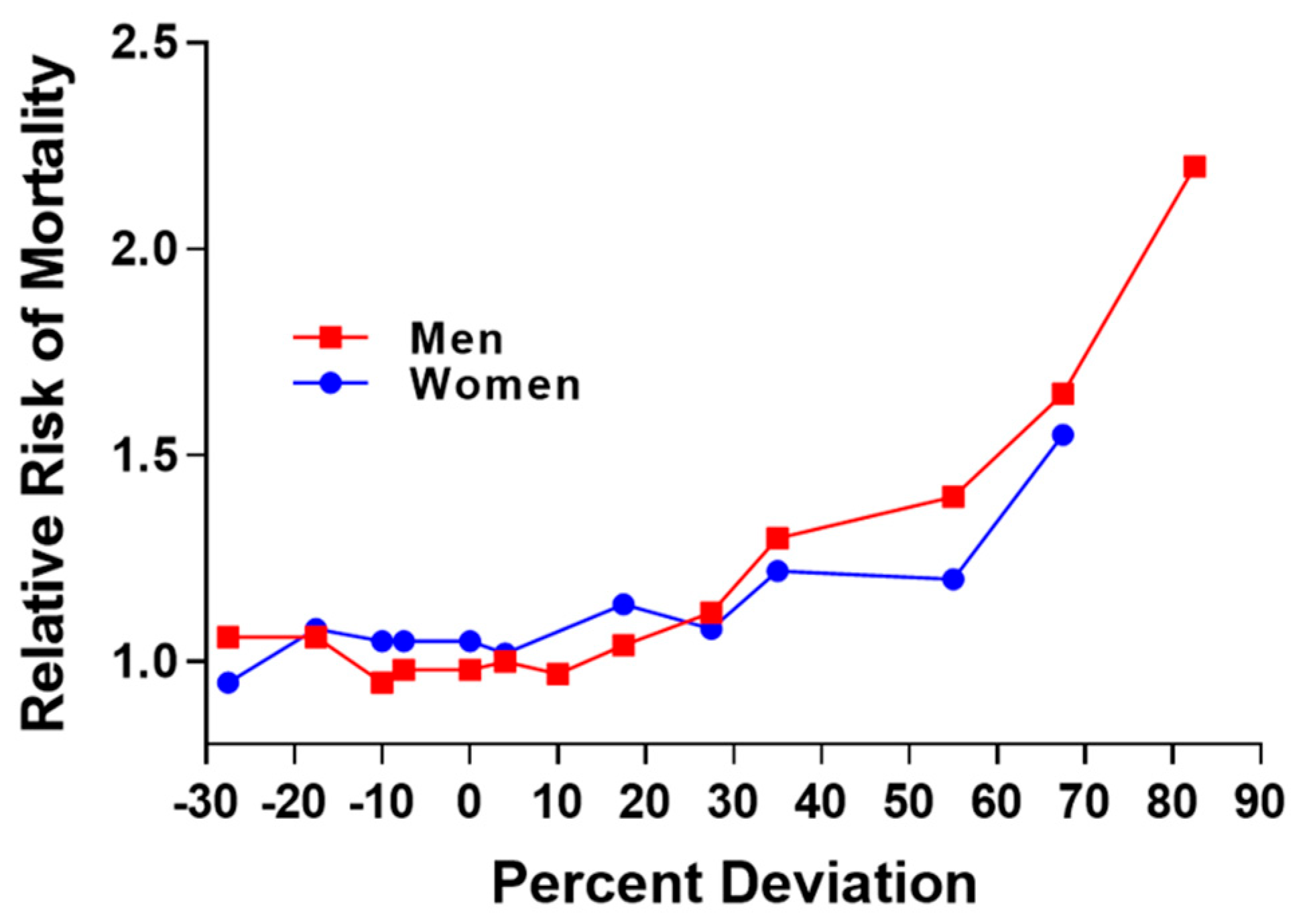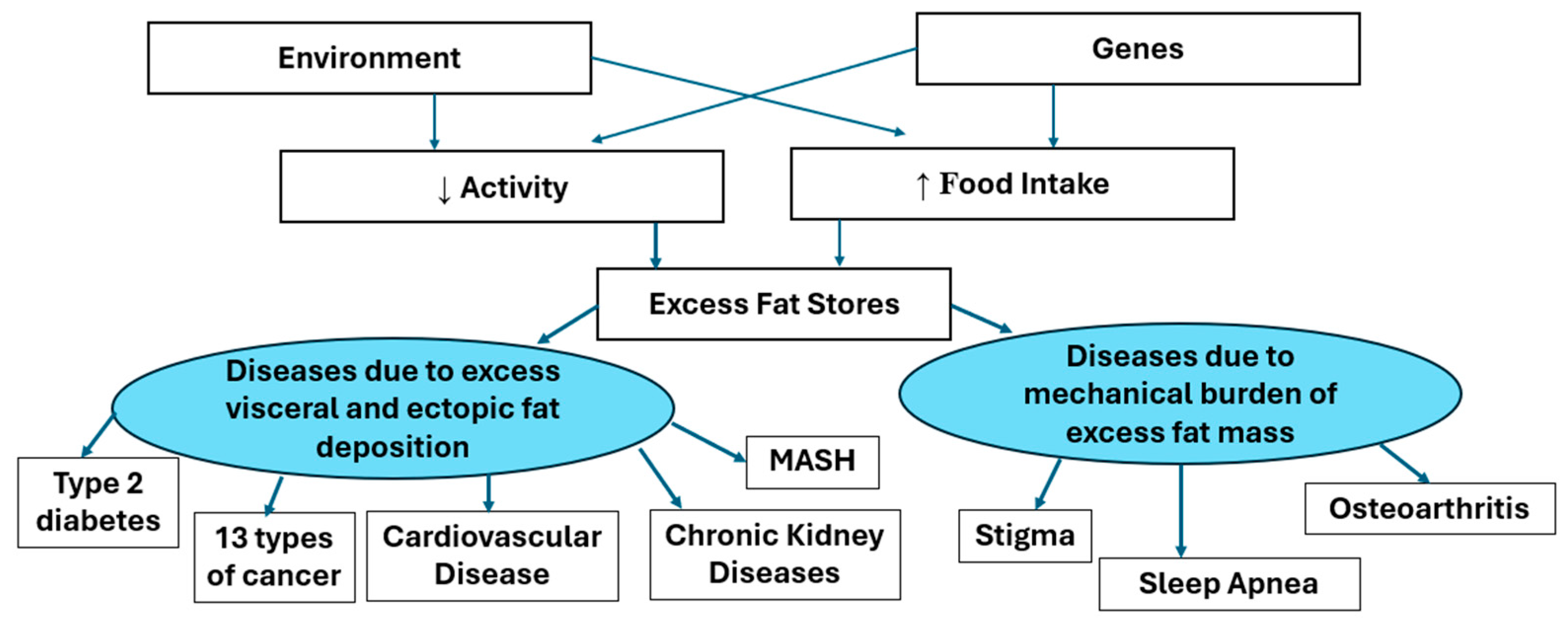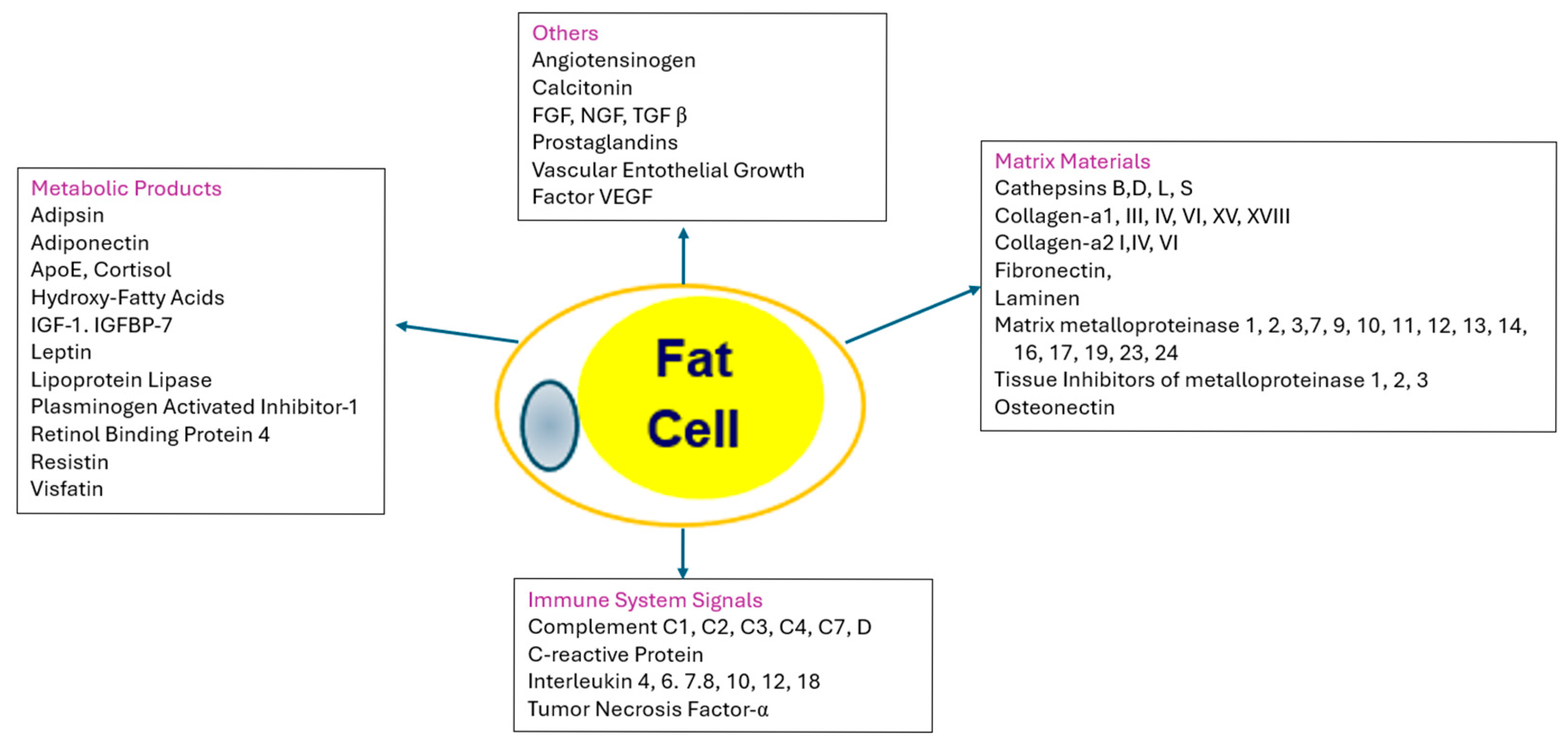Beyond Obesity
Abstract
1. The Recognition of Clinical Obesity
2. Adipose Tissue, Weight, and Risk to Health
3. Body Mass Index
4. Measuring Regional Fat Distribution Changed the View of Body Fat
5. Limitations to the Term “Obesity”
6. What Are the Alternatives to the Term “Obesity”?
7. New Drugs Have Shifted the Treatment Paradigm for Adiposity
Author Contributions
Funding
Institutional Review Board Statement
Informed Consent Statement
Data Availability Statement
Conflicts of Interest
References
- Rubino, F.; Cummings, D.E.; Eckel, R.H.; Cohen, R.V.; Wilding, J.P.H.; Brown, W.A. Definition and diagnostic criteria of clinical obesity. Lancet Diabetes Endocrinol. 2025, 13, 221–262. [Google Scholar] [CrossRef]
- Busetto, L.; Dicker, D.; Frühbeck, G.; Halford, J.C.G.; Sbraccia, P.; Yumuk, V.; Goossens, G.H. A new framework for the diagnosis, staging and management of obesity in adults. Nat. Med. 2024, 30, 2395–2399. [Google Scholar] [CrossRef] [PubMed]
- World Health Organization. 1 March 2024. Available online: https://www.who.int/health−topics/obesity#tab=tab_1 (accessed on 6 January 2025).
- Komaroff, M. For researchers on obesity: Historical review of extra body weight definitions. J. Obes. 2016, 2016, 2460285. [Google Scholar] [CrossRef] [PubMed]
- Bray, G.A. Life insurance and overweight. Obes. Res. 1995, 3, 97–99. [Google Scholar] [CrossRef] [PubMed]
- The Build and Blood Pressure Study; The Society of Actuaries: Chicago, IL, USA, 1959.
- Bray, G.A. (Ed.) Obesity in perspective. Fogarty International Center Series on Preventive Medicine; Govt. PRTG Office: Washington, DC, USA, 1976; Volume 2. [Google Scholar]
- Bray, G.A. Commentary on classics in obesity 1. Quetelet: Quantitative medicine. Obes. Res. 1994, 2, 68–71. [Google Scholar] [CrossRef] [PubMed]
- Keys, A.; Fidanza, F.; Karvonen, M.J.; Kimura, N.; Taylor, H.L. Indices of relative weight and obesity. J. Chronic. Dis. 1972, 25, 329–343. [Google Scholar] [CrossRef] [PubMed]
- Prospective Studies Collaboration; Whitlock, G.; Lewington, S.; Sherliker, P.; Clarke, R.; Emberson, J. Body−mass index and cause−specific mortality in 900,000 adults: Collaborative analyses of 57 prospective studies. Lancet 2009, 373, 1083–1096. [Google Scholar] [CrossRef] [PubMed] [PubMed Central]
- Flegal, K.M.; Carroll, M.D.; Kuczmarski, R.J.; Johnson, C.L. Overweight and obesity in the United States: Prevalence and trends, 1960–1994. Int. J. Obes. Relat. Metab. Disord. 1998, 22, 39–47. [Google Scholar] [CrossRef] [PubMed]
- Ogden, C.L.; Yanovski, S.Z.; Carroll, M.D.; Flegal, K.M. The epidemiology of obesity. Gastroenterology 2007, 132, 2087–2102. [Google Scholar] [CrossRef] [PubMed]
- Flegal, K.M.; Kruszon−Moran, D.; Carroll, M.D.; Fryar, C.D.; Ogden, C.L. Trends in obesity among adults in the United States, 2005 to 2014. JAMA 2016, 315, 2284–2291. [Google Scholar] [CrossRef] [PubMed] [PubMed Central]
- Rodgers, A.; Woodward, A.; Swinburn, B.; Dietz, W.H. Prevalence trends tell us what did not precipitate the US obesity epidemic. Lancet Public Health 2018, 3, e162–e163. [Google Scholar] [CrossRef] [PubMed]
- Caleyachetty, R.; Barber, T.M.; Mohammed, N.I.; Cappuccio, F.P.; Hardy, R.; Mathur, R.; Banerjee, A.; Gill, P. Ethnicity−specific BMI cutoffs for obesity based on type 2 diabetes risk in England: A population−based cohort study. Lancet Diabetes Endocrinol. 2021, 9, 419–426. [Google Scholar] [CrossRef]
- Bray, G.A. Beyond BMI. Nutrients 2023, 15, 2254. [Google Scholar] [CrossRef] [PubMed] [PubMed Central]
- New Adult Obesity ICD−10−CM CodesPartner Promotion Materials. Available online: https://www.cdc.gov/obesity/media/pdfs/2024/12/adult−partner−promotion−materials−icd−10−codes−508.pdf (accessed on 24 August 2025).
- Childhood Obesity Codes. Available online: https://www.cdc.gov/obesity/media/pdfs/2024/12/Child−Obesity−ICD−10−CM−Table_1.pdf (accessed on 24 August 2025).
- Anumula, N.; Sanelli, P.C. Meaningful use. AJNR Am. J. Neuroradiol. 2012, 33, 1455–1457. [Google Scholar] [CrossRef] [PubMed]
- von Norden, K.H. Metabolism and Practical Medicine; Heineman Publishers: London, UK, 1907. [Google Scholar]
- Vague, J. The degree of masculine differentiation of obesities: A factor determining predisposition to diabetes, atherosclerosis, gout, and uric calculous disease. Am. J. Clin. Nutr. 1956, 4, 20–34. [Google Scholar] [CrossRef]
- Vague, J. Sexual differentiation: A determinant of the forms of obesity. Obesity Res. 1996, 4, 102. [Google Scholar] [CrossRef]
- Kissebah, A.H. Relation of body fat distribution to metabolic complications of obesity. J. Clin. Endocrinol. Metab. 1982, 54, 254–260. [Google Scholar] [CrossRef] [PubMed]
- Krotkiewski, M.; Bjorntorp, P.; Sjostrom, L.; Smith, U. Impact of obesity on metabolism in men and women: Importance of regional adipose tissue distribution. J. Clin. Investig. 1983, 72, 1150–1162. [Google Scholar] [CrossRef] [PubMed]
- Lapidus, L.; Bengtsson, C.; Larsson, B.; Pennert, K.; Rybo, E.; Sjostrom, L. Distribution of adipose tissue and risk of cardiovascular disease and death: A 12 year follow up of participants in the population study of 1462 women in Gothenberg, Sweden. Br. Med. J. 1984, 289, 1257–1261. [Google Scholar] [CrossRef]
- Larsson, B.; Svardsudd, K.; Welin, L.; Wihelmsen, L.; Bjorntorp, P.; Tibbllne, G. Abdominal adipose tissue distribution, obesity and risk of cardiovascular disease and death: 13 year follow up of participants in the study of 792 men born in 1913. Br. Med. J. 1984, 288, 1401–1404. [Google Scholar] [CrossRef]
- Ashwell, M.; Gunn, P.; Gibson, S. Waist−to−height ratio is a better screening tool than waist circumference and BMI for adult cardiometabolic risk factors: Systematic review and meta−analysis. Obes. Rev. 2012, 13, 275–286. [Google Scholar] [CrossRef] [PubMed]
- Volger, S.; Vetter, M.L.; Dougherty, M.; Panigrahi, E.; Egner, R.; Webb, V.; Thomas, J.G.; Sarwer, D.B.; Wadden, T.A. Patients’ preferred terms for describing their excess weight: Discussing obesity in clinical practice. Obesity 2012, 20, 147–150. [Google Scholar] [CrossRef]
- Banting, W. Letter on Corpulence, Addressed to the Public, 3rd ed.; Harrison: London, UK, 1864; pp. 7–50. [Google Scholar]
- Richardson, S.A.; Hasdorf, A.H.; Goodman, N.; Dornbush, S.M. Cultural uniformity in reaction to physical disability. Am. Sociol. Rev. 1961, 26, 241–247. [Google Scholar] [CrossRef]
- Latner, J.D.; Stunkard, A.J. Getting worse: The stigmatization of obese children. Obes. Res. 2003, 11, 452–456. [Google Scholar] [CrossRef] [PubMed]
- Puhl, R.M. Facing challenges for reducing weight stigma in public health policy and practice. Annu. Rev. Public Health. 2025, 46, 133–150. [Google Scholar] [CrossRef] [PubMed]
- Puhl, R. Bias, Discrimination in Obesity. In Handbook of Obesity, 4th ed.; Bray, G.A., Bouchard, C., Katzmarzyk, P.T., Kirwan, J.M., Redman, L.M., Schauer, P.S., Eds.; CRC Press: Boca Raton, FL, USA, 2024; Volume 1, pp. 617–626. [Google Scholar] [CrossRef]
- Sobal, J.; Stunkard, A.J. Socioeconomic status and obesity: A review of the literature. Psychol. Bull. 1989, 105, 260–275. [Google Scholar] [CrossRef] [PubMed]
- Garvey, W.T.; Mechanick, J.I.; Brett, E.M.; Garber, A.J.; Hurley, D.L.; Jastreboff, A.M.; Nadolsky, K.; Pessah-Pollack, R.; Plodkowski, R.; Reviewers of the AACE/ACE Obesity Clinical Practice Guidelines. American Association of Clinical Endocrinologists and American College of Endocrinology comprehensive clinical practice guidelines for medical care of patients with obesity. Endocr. Pract. 2016, 22 (Suppl. S3), 1–203. [Google Scholar] [CrossRef]
- Jensen, M.D.; Ryan, D.H.; Apovian, C.M.; Ard, J.D.; Comuzzie, A.G.; Donato, K.A.; Hu, F.B.; Hubbard, V.S.; Jakicic, J.M.; Kushner, R.F.; et al. 2013 AHA/ACC/TOS guideline for the management of overweight and obesity in adults: A report of the American College of Cardiology/American Heart Association Task Force on Practice Guidelines and The Obesity Society. J. Am. Coll. Cardiol. 2014, 63 Pt B25, 2985–3023. [Google Scholar] [CrossRef]
- Wharton, S.; Lau, D.C.; Vallis, M.; Sharma, A.M.; Biertho, L.; Campbell−Scherer, D.; Adamo, K.; Alberga, A.; Bell, R.; Boulé, N.; et al. Obesity in adults: A clinical practice guideline. CMAJ 2020, 192, E875–E891. [Google Scholar] [CrossRef] [PubMed]
- Markovic, T.P.; Proietto, J.; Dixon, J.B.; Rigas, G.; Deed, G.; Hamdorf, J.M.; Bessell, E.; Kizirian, N.; Andrikopoulos, S.; Colagiuri, S. The Australian Obesity Management Algorithm: A simple tool to guide the management of obesity in primary care. Obes. Res. Clin. Pract. 2022, 16, 353–363. [Google Scholar] [CrossRef] [PubMed]
- Alfadda AAAl−Dhwayan, M.M.; Alharbi, A.A.; Al Khudhair, B.K.; Al Nozha, O.M.; Al−Qahtani, N.M.; Alzahrani, S.H.; Bardisi, W.M.; Sallam, R.M.; Riva, J.J.; Brożek, J.L.; et al. The Saudi clinical practice guideline for the management of overweight and obesity in adults. Saudi. Med. J. 2016, 37, 1151–1162. [Google Scholar] [CrossRef] [PubMed]
- Yumuk, V.; Tsigos, C.; Fried, M.; Schindler, K.; Busetto, L.; Micic, D.; Hermann, T. Obesity Management Task Force of the European Association for the Study of Obesity—European guidelines for obesity management in adults. Obes. Facts. 2015, 8, 402–424. [Google Scholar] [CrossRef]
- National Institute for Health and Care Excellence (NICE). Obesity: Identification, Assessment and Management—Clinical Guideline. 2014. Available online: https://www.nice.org.uk/guidance/cg189 (accessed on 24 August 2025).
- Mechanick, J.I.; Hurley, D.L.; Garvey, W.T. Adiposity−based chronic disease as a new diagnostic term: The American Association of Clinical Endocrinologists and American College of Endocrinology Position Statement. Endocr. Pract. 2017, 23, 372–378. [Google Scholar] [CrossRef] [PubMed]
- Garvey, W.T. Is obesity or adiposity−based chronic disease curable: The set point theory, the environment, and second−generation medications. Endocr. Pract. 2022, 28, 214–222. [Google Scholar] [CrossRef] [PubMed]
- Frühbeck, G.; Busetto, L.; Dicker, D.; Yumuk, V.; Goossens, G.H.; Hebebrand, J.; Halford, J.G.; Farpour−Lambert, N.J.; Blaak, E.E.; Woodward, E.; et al. The ABCD of obesity: An EASO position statement on a diagnostic term with clinical and scientific implications. Obes. Facts. 2019, 12, 131–136. [Google Scholar] [CrossRef] [PubMed] [PubMed Central]
- O’Rahilly, S. “Treasure your exceptions”−studying human extreme phenotypes to illuminate metabolic health and disease: The 2019 Banting Medal for Scientific Achievement Lecture. Diabetes 2021, 70, 29–38. [Google Scholar] [CrossRef]
- McGrosky, A.; Luke, A.; Arab, L.; Bedu−Addo, K.; Bonomi, A.G.; Bovet, P. IAEA DLW Database Consortium. Energy expenditure and obesity across the economic spectrum. Proc. Natl. Acad. Sci. USA 2025, 122, e2420902122. [Google Scholar] [CrossRef] [PubMed] [PubMed Central]
- Lane, M.M.; Davis, J.A.; Beattie, S.; Gómez−Donoso, C.; Loughman, A.; O’Neil, A.; Jacka, F.; Berk, M.; Page, R.; Marx, W.; et al. Ultraprocessed food and chronic noncommunicable diseases: A systematic review and meta−analysis of 43 observational studies. Obes. Rev. 2021, 22, e13146. [Google Scholar] [CrossRef] [PubMed]
- Halberg, N.; Wernstedt−Asterholm, I.; Scherer, P.E. The adipocyte as an endocrine cell. Endocrinol. Metab. Clin. N. Am. 2008, 37, 753–768, x–xi. [Google Scholar] [CrossRef] [PubMed] [PubMed Central]
- Sweatt, K.; Garvey, W.T.; Martins, C. Strengths and limitations of BMI in the diagnosis of obesity: What is the path forward? Curr. Obes. Rep. 2024, 13, 584–595. [Google Scholar] [CrossRef] [PubMed] [PubMed Central]
- Heymsfield, S.B.; Bourgeois, B.; Ng, B.K.; Sommer, M.J.; Li, X.; Shepherd, J.A. Digital anthropometry: A critical review. Eur. J. Clin. Nutr. 2018, 72, 680–687. [Google Scholar] [CrossRef] [PubMed]
- Gudzune, K.A.; Kushner, R.F. Medications for Obesity: A Review. JAMA 2024, 332, 571–584. [Google Scholar] [CrossRef] [PubMed]
- Itani, L.; El Ghoch, M. Waist−to−Height Ratio Cut−Off Points for Central Obesity in Individuals with Overweight Across Different Ethnic Groups in NHANES 2011–2018. Nutrients 2024, 16, 3838. [Google Scholar] [CrossRef] [PubMed]




| Preclinical Obesity | Clinical Obesity | |
|---|---|---|
| Measure: Body Fat Height and Weight Waist Circumference | >25% for males; >30−38% females BMI 25−40 kg/m2 Waist/Height <0.5 | Same as Preclinical Obesity |
| Physiopathology | Alterations of cells and tissues leading to alteration of organ structure | Alteration of organ function leading to end organ damage |
| Clinical Manifestations | Minor or absent; substantially preserved organ function | Signs and symptoms; Limitations in daily activity; Complications |
| Detection and Diagnosis | Anthropometrics, medical history, Review of Systems, further diagnostic workup as needed | Same as Preclinical Obesity |
| Treatment approach | Focus on prevention of risk, reduction and progression to clinical obesity or other disease | Focus on improvement or reversal of organ dysfunction |
| Woman | Man | ||||||
|---|---|---|---|---|---|---|---|
| Height (Feet/ Inches) | Weight (lbs) | Height (Feet/ Inches) | Weight (lbs) | ||||
| Frame | Frame | ||||||
| Small | Medium | Large | Small | Medium | Large | ||
| 4′10″ | 102−111 | 109−121 | 118−131 | 5′2″ | 128−134 | 131−141 | 138−150 |
| 4′11″ | 103−113 | 111−123 | 120−134 | 5′3″ | 130−136 | 133−143 | 140−153 |
| 5′0″ | 104−115 | 113−126 | 122−137 | 5′4″ | 132−138 | 135−145 | 142−156 |
| 5′1″ | 106−118 | 115−129 | 125−140 | 5′5″ | 134−140 | 137−148 | 144−160 |
| 5′2″ | 108−121 | 118−132 | 128−143 | 5′6″ | 135−142 | 139−151 | 146−164 |
| 5′3″ | 111−124 | 121−135 | 131−147 | 5′7″ | 138−145 | 142−154 | 149−168 |
| 5′4″ | 114−127 | 124−138 | 134−151 | 5′8″ | 140−148 | 145−157 | 152−172 |
| 5′5″ | 117−130 | 127−141 | 137−155 | 5′9″ | 142−151 | 148−160 | 155−176 |
| 5′6″ | 120−133 | 130−144 | 140−159 | 5′10″ | 144−154 | 151−163 | 158−180 |
| 5′7″ | 123−136 | 133−147 | 143−163 | 5′11″ | 146−157 | 154−166 | 161−184 |
| 5′8″ | 126−139 | 136−150 | 146−167 | 6′0″ | 149−160 | 157−170 | 164−188 |
| 5′9″ | 129−142 | 139−153 | 149−170 | 6′1″ | 152−164 | 160−174 | 168−192 |
| 5′10″ | 132−145 | 142−152 | 152−173 | 6′2″ | 155−168 | 164−178 | 172−197 |
| 5′11″ | 135−148 | 145−159 | 155−176 | 6′3″ | 158−172 | 167−182 | 176−202 |
| 6′0″ | 138−151 | 148−162 | 158−179 | 6′4″ | 162−176 | 171−187 | 181−207 |
| Ethnicity/Race | BMI Cutoff Point to Trigger Weight Management |
|---|---|
| White UK (reference population) | 30 kg/m2 |
| Black | 30 kg/m2 |
| -Black British | 29 kg/m2 |
| -Black African | 29 kg/m2 |
| -Black Caribbean | 26 kg/m2 |
| -Black other | 27 kg/m2 |
| Arab and Chinese | 27 kg/m2 |
| South Asian | 24 kg/m2 |
| -Pakistani, Indian, and Nepali | 24 kg/m2 |
| -Tamil and Sri Lankan | 23 kg/m2 |
| -Bangladeshi | 21 kg/m2 |
| Prevalence. | Of US adults with obesity, 19-40% report weight discrimination. These rates increase with rising BMI and are of more concern to women than men. |
| School | Bullying is the most common school stigmatization. |
| Healthcare | Many healthcare professionals are prejudiced against people with obesity. |
| Media | Media outlets reinforce negative stereotypes of people with obesity. |
| Home Environment | Family members contribute to weight-based teasing. |
| Health Consequences | Stigmatization contributes to depression, anxiety, low self-esteem and lower physical activity; these are documented in childhood, adolescence, and adulthood. |
| Legal | To date, there are no federal laws that prohibit weight discrimination. |
| Sponsoring Organization, Year, Reference | Recommendations |
|---|---|
| American Association of Clinical Endocrinologists and American College of Endocrinology 2016 [35] |
|
| American College of Cardiology, American Heart Association and The Obesity Society 2014 [36] |
|
| Obesity Canada 2022 [37] |
|
| Australian Guidelines 2022 [38] |
|
| Saudi Clinical Practice Guideline 2016 [39] |
|
| European Guidelines 2015 [40] |
|
| NICE Guidelines 2014 [41] |
|
| BMI | Waist/Height (Measure of Central Adiposity) | Symptoms Related to Excess Adiposity | |
|---|---|---|---|
| Healthy weight | <30 | <0.5 | None |
| Healthy weight | 30 < 35 | <0.5 | None |
| Adiposity I | <30, plus | ≥0.5 (either or both) | Yes (either or both) |
| Adiposity II | 30 < 40, plus | ≥0.5 (either or both) | Yes (either or both) |
| Adiposity III | ≥40 | No need to measure | No need to ascertain |
Disclaimer/Publisher’s Note: The statements, opinions and data contained in all publications are solely those of the individual author(s) and contributor(s) and not of MDPI and/or the editor(s). MDPI and/or the editor(s) disclaim responsibility for any injury to people or property resulting from any ideas, methods, instructions or products referred to in the content. |
© 2025 by the authors. Licensee MDPI, Basel, Switzerland. This article is an open access article distributed under the terms and conditions of the Creative Commons Attribution (CC BY) license (https://creativecommons.org/licenses/by/4.0/).
Share and Cite
Bray, G.A.; Ryan, D.H. Beyond Obesity. Med. Sci. 2025, 13, 176. https://doi.org/10.3390/medsci13030176
Bray GA, Ryan DH. Beyond Obesity. Medical Sciences. 2025; 13(3):176. https://doi.org/10.3390/medsci13030176
Chicago/Turabian StyleBray, George A., and Donna H. Ryan. 2025. "Beyond Obesity" Medical Sciences 13, no. 3: 176. https://doi.org/10.3390/medsci13030176
APA StyleBray, G. A., & Ryan, D. H. (2025). Beyond Obesity. Medical Sciences, 13(3), 176. https://doi.org/10.3390/medsci13030176





